Many digital TV users are wondering if the antenna with an amplifier such as a polish grid will be compatible with DVB-T2 reception
. This problem became especially urgent after the government took measures to improve the signal and most regions were connected to
digital television broadcasting .
- Is the Polish grille suitable for receiving digital TV?
- Main technical characteristics of the Polish antenna
- How does the TV antenna “Pole” work when receiving a digital signal?
- Choosing an amplifier for polish lattice for long distance reception of DVB-T2 signal
- Potential problems when trying to receive digital TV using polish grille
- What if the polish grid does not accept DVB T2?
- The first way
- Second way
- Third way
- Fourth way
- Antenna mount
Is the Polish grille suitable for receiving digital TV?
An antenna of the Polish mesh type at one time quickly spread throughout the country and gained popularity among many users. This equipment is unpretentious in maintenance and does not require additional modifications after installation. With the advent of digital broadcasting DVB-T2 in the country, users began to find various
amplifiers for this type of antenna, allowing them to capture a digital signal and broadcast it to a TV.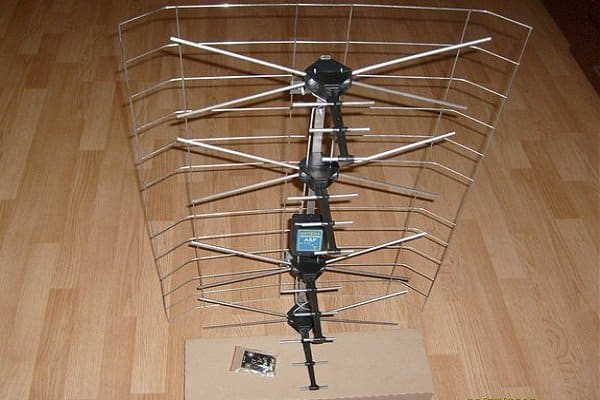 The antenna array itself is broadband. In other words, such equipment is capable of receiving various signals of both meter and decimeter wavelengths. This unique property allows the device to catch signals from digital TV channels in the DVB-T2 format.
The antenna array itself is broadband. In other words, such equipment is capable of receiving various signals of both meter and decimeter wavelengths. This unique property allows the device to catch signals from digital TV channels in the DVB-T2 format.
The polish grille is not the most suitable option used for long-distance reception of digital TV channels. This is primarily due to the fact that the device requires improvements and upgrades before it will function in the desired range.
Main technical characteristics of the Polish antenna
The Poles’ range operates from 40 to 800 MHz. This allows you to receive signals and watch TV programs from 1 to 20 channels. With a little refinement and connection of the amplifier, it also becomes possible to view TV channels from 21 to 69. Additionally, in the basic configuration of any models of grid-type antennas, there is its own signal amplification up to 13 decibels, as well as a characteristic impedance of 300 ohms. The dimensions of the equipment are relatively small (80×60 cm), the weight is 1.5 kg. The list of antenna components upon purchase is impressive:
- active vibrators (UHF, MV);
- passive vibrators (directors);
- rails for fixing baselines of waveguides and plastic housings;
- mount an antenna with a reflector;
- undervoltage units;
- various amplifier models at the buyer’s choice;
- standard plugs for connection.
The coaxial cables required to connect the device to the translator are purchased separately.
How does the TV antenna “Pole” work when receiving a digital signal?
The basic set
does not imply the use of equipment for the purpose of receiving 10 or 20 digital TV channels spread throughout the country… In any case, until there is an official update of the antenna from the manufacturer, you will have to improve it yourself in order to achieve the required signal level. With proper refinement, the Polish grille responds well to long-range digital signal reception. There is a small percentage of the likelihood that, due to the similar reception range of the signal, the antenna can partially catch the image and broadcast sound without modification. However, the signal will be weak and difficult to fix on a permanent basis. The standard amplifier that comes with the antenna arrays is also not suitable for working with digital television. It needs to be upgraded to improve signal reception. The positive effect is achieved only if the antenna is located near the repeater tower.In this case, a minimum amount of funds is required to work on amplifying or decreasing the signal in order to achieve a high quality image using standard devices available in stores and electronics markets.
Choosing an amplifier for polish lattice for long distance reception of DVB-T2 signal
Without an amplifier, the Polish grid will not be able to receive and process the incoming signals of the new generation. The basic amplifier in the Polish antenna is produced separately. In electronics stores, you can buy it for no more than 200 rubles.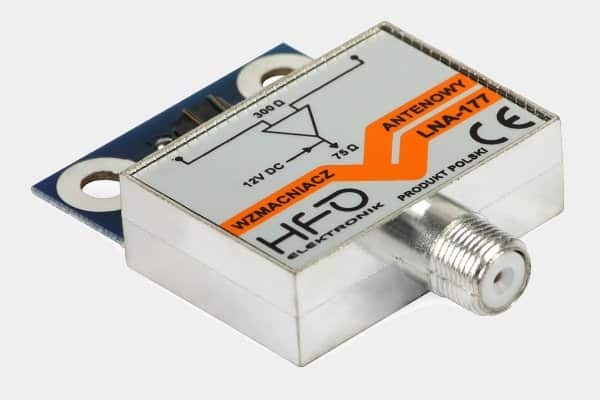 When choosing an amplifier, it all depends on what signal range the user needs to use for reception. Each radio technical element of a standard amplifier is fixed using a hinged method on the main part of the antenna. It is there, in the central part of the equipment, that a small protected box is located. Through the board installed in it, you can achieve an improvement in the signal reception effect.
When choosing an amplifier, it all depends on what signal range the user needs to use for reception. Each radio technical element of a standard amplifier is fixed using a hinged method on the main part of the antenna. It is there, in the central part of the equipment, that a small protected box is located. Through the board installed in it, you can achieve an improvement in the signal reception effect.
The main task of digital antenna amplifiers is to improve the quality of incoming television signals. Any of the models on the market equally well amplifies the signals of the received broadcast – their quality depends on the distance from the main repeater.
To select a specific amplifier model, depending on the power and distance from the TV tower, you can follow the table:
| Amplifier types | Applied gain level in dB | Amplifier noise produced in dB | Distance from the tower transmitting the signal, km | |
| Receive channels 1 to 21 | Receive channels 21 to 68 | |||
| SWA 1 and Lux | 2-14 | 8-23 | up to 2.8 | 3-15 |
| SWA 2 | 15-18.5 | 20-25 | up to 2.8 | 10-20 |
| SWA 3 | 2-6 | 20.5-28 | up to 3.1 | 10-30 |
| SWA 4 Lux | 0-8 | 29-35 | up to 3.0 | 20-45 |
| SWA 5.6.7 | 5-17 | 25-38 | from 1 to 3.9 | 10-70 |
| SWA 9 to 65 | 9-20 | 21-43 | from 1.9 to 3.1 | 30-100 |
| SWA 555 Lux | 10-15 | 34-43 | 2.2 | 50-100 |
| SWA 777 Lux | 10-13 | 34-45 | 2,3 | 50-100 |
| SWA 999 to 9999 | 0-52 | 10-54 | from 1.2 to 2.9 | 20-150 |
In shops and on the radio market you can find a large number of translators for the Polish antenna. Buyers can choose from dozens of models. They all have the same dimensions, and differ in reception quality and signal strength from 30 to 48 decibels. All amplifier boards, including those for receiving a digital signal, have a voltage of 12 volts, which they receive from low voltage power supply units 220 by 12 volts. All incoming voltage, which goes to the main board located on the antenna, passes through a special plug with a built-in capacitor. With its help, there is a separation into power supply and incoming signal.
When choosing the right type of amplifier for the array antenna, you can contact your neighbors or see which model they have installed on the roof. Using the table, you can calculate the approximate level of the digital signal that will reach your equipment.
Potential problems when trying to receive digital TV using polish grille
Normally working Polish antennas with an amplifier and a power supply may experience the following malfunctions:
- the signal starts to disappear completely;
- when setting up digital television broadcasting, the scale showing the signal level begins to rapidly increase to 100 or, conversely, drops to 0;
- at first there is a reception, but over time it begins to weaken or completely disappear;
- the image starts to slow down, cubes appear, the sound starts to stutter;
- of the 20 channels available for free broadcasting, only 10 are shown – and even then with a bad image;
- if the antenna is located at a low height of up to 2.5-3 meters, then cars passing by it on the road may cause the signal to start to junk.
All this leads to the need for improvements to improve the quality of reception and prevent various kinds of problems.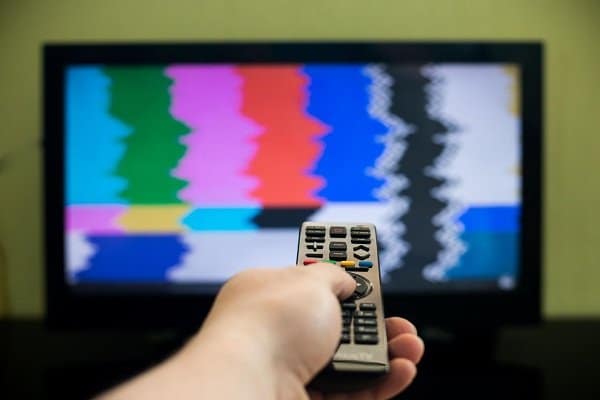
If you tune the receive signal for digital broadcasting and you see that the level indicator starts to rise and fall quickly, this means that it is lost. In other words, such a digital signal through the Pole is unsuitable to decode it. In this case, the equipment will need to be modified.
What if the polish grid does not accept DVB T2?
If “Pole” does not accept DVB T2 and does not react in any way to manual settings, this cannot be the fault of the TV. Many users believe that the basic gain found in modern plasma and LCD devices is sufficient to gain access to the level of digital broadcasting. According to many vendors, modern TVs have the ability to receive a signal without connecting antennas. However, in practice, it turns out that the further a person is from the signal repeater, the worse the reception becomes. This state of affairs is especially noticeable in remote areas of the country, which recently switched to digital television broadcasting. On repeater towers, amplification has to be added so that local residents can achieve the same quality as channels in urban environments.In many cases, the cause of a bad signal in DVB-T2 reception is increased power. An improperly sized translator can significantly increase the outgoing performance, resulting in interference. There are four ways to correct this problem and get the best digital TV reception. Modernization of the Polish antenna for DVB T2: https://youtu.be/SiIg8yWLaY8
The first way
If the user has a regulated power supply, then there will be no problem with changing the power of the repeater. Typically, these controls are manually operated. To reduce the incoming power, simply turn the screws counterclockwise on the center panel of the amplifier. In this case, the voltage drops below 12 volts. The minimum limit is 2 volts. It is necessary to reduce the signal level when the TV broadcast is on in order to monitor how it is displayed on its playback on TV. When the signal level changes, its change in the picture display quality will take place with a slight delay, so it is worth waiting a little.
Second way
The latest TVs are equipped with various tuners with the ability to receive a digital signal. In this case, you can use a little trick to drastically reduce the power going to the antenna adapter. This will use the USB port from the TV. To do this, you need to do the following:
- Take the TV cable and install the TV plug.
- Purchase an adapter that allows the antenna to be powered via the USB port.
- Connect the adapter to the port and route the power cable into the antenna amplifier.
The price of such a USB power adapter does not exceed 300 rubles. It is available in almost all electronics stores and does not require any special skills to install.
Third way
If you have a set-top box for receiving digital TV at home, you can direct the power from it directly to the antenna-array amplifier. In this case, instead of the installed 12 volts, no more than 5 volts from the set-top box will flow through the pre-connected TV cable to the mounted amplifier located in the upper part of the antenna. To do this, you need to follow only 3 simple steps:
To do this, you need to follow only 3 simple steps:
- Fix the standard TV plug to the TV cable.
- Connect the set-top box to the TV.
- Open the set-top box menu and select the item in which the antenna power is activated.
Depending on the model of the set-top box, the menu and the method of activating the antennas may differ, so you must refer to the instructions supplied with the device.
Fourth way
You can experiment and turn off the antenna power completely. In some cases (depending on the location of the antenna and the repeater), the signal can arrive this way. To do this, you need to do the following:
- Get a TV box.
- Prepare a TV cable with a plug.
- Connect the cable to the set-top box and antenna directly without power.
This method is not always effective, since the power supply can be completely zero, and the signal will attenuate from the moment the TV channel is turned on.
Antenna mount
Another popular question among users is where to place it and how to properly install the polish grille. First of all, you need to carefully study the information on this matter in the instructions included with the equipment, which indicate the main parameters for placing the device. The basic equipment of any antenna model has a special mast for fixing the antenna. To secure the antenna to the mast, you will need to use the supplied tie-down bolt clamp. This can be done immediately on the ground until the moment when the antenna is placed at the required height.
Before lifting the antenna mast and fixing it, for example, on the roof, you will need to prepare the antenna cable, as well as the power cable, which is better to connect immediately when attaching the device to the mast.
As for the choice of the height and location of the digital signal receiver itself, then the parameters are always individual and depend on where the user lives. When installing “Poles” it is recommended to adhere to the following algorithm:
- Connect the signal receiver to the TV.
- Apply voltage to the signal amplifier, which is also connected to the antenna.
- Determine the location relative to the nearest television tower.
- Expand the antenna array towards the TV tower.
To improve the quality of reception, slowly raise the signal receiver on the mast. At the moment when the picture and sound are of maximum quality, you should fix the mast with the antenna in this position.
After the user has fixed all the wires so that the block is sealed from the outside, it must be coated along the seam with waterproof glue. This will maximize the quality of signal reception, avoiding the possibility of moisture getting inside. The Polish antenna is capable of receiving waves of the established ranges only from one side. When turning the antenna towards the tower, it will receive only the direct incoming signal. To improve the quality of reception, if there are several television towers around, it is necessary to install receivers with the same range towards them. Watch a video on how to set up a Pole antenna for effective reception of digital television: https://www.youtube.com/watch?v=2nPuYzAL0ug Upgraded,a properly tuned and fixed antenna of the Polish grid type does an excellent job with the reception of modern digital television broadcasting. An upgrade of this equipment is available to any user and does not require much effort or large financial investments.

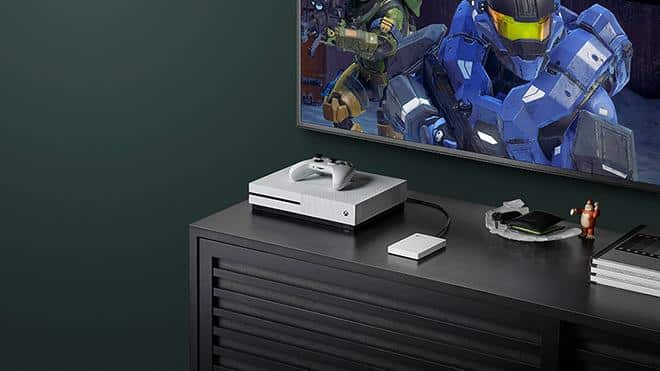
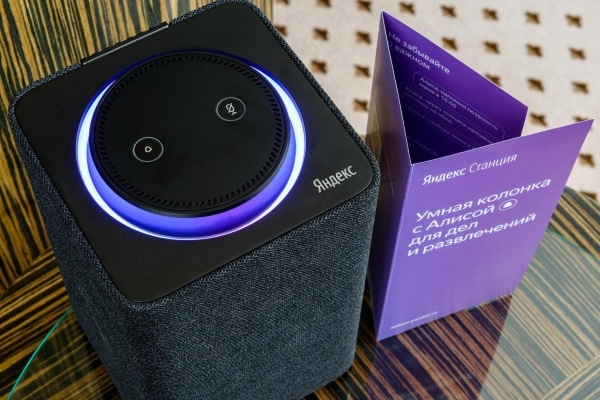
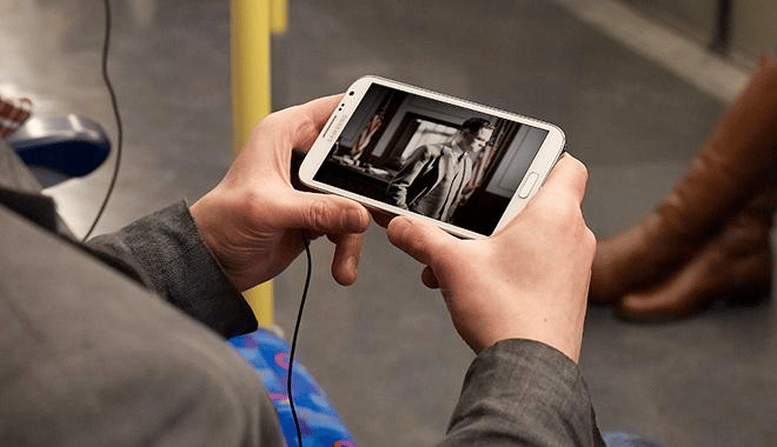
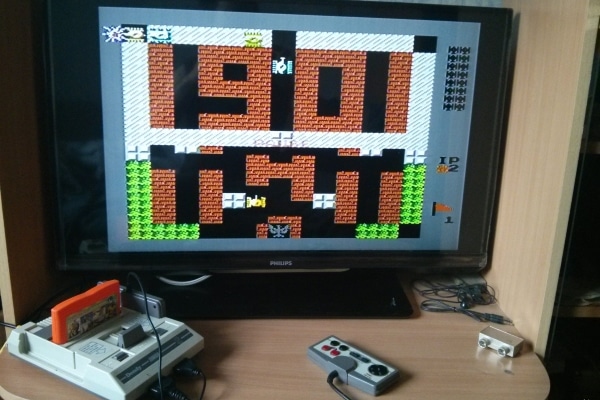
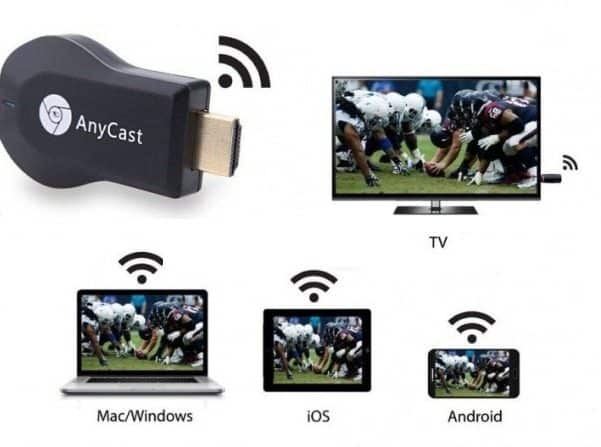
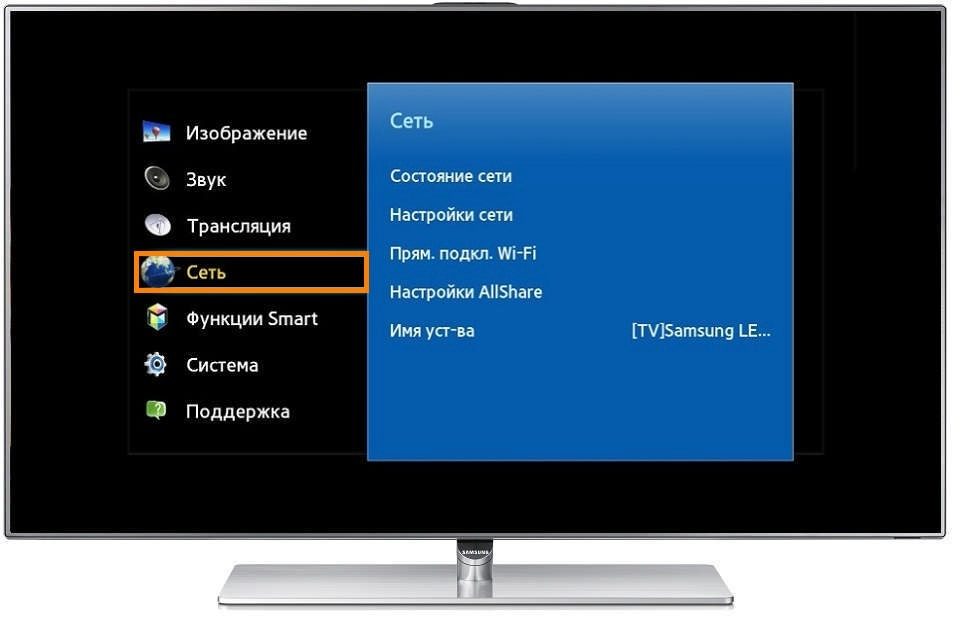
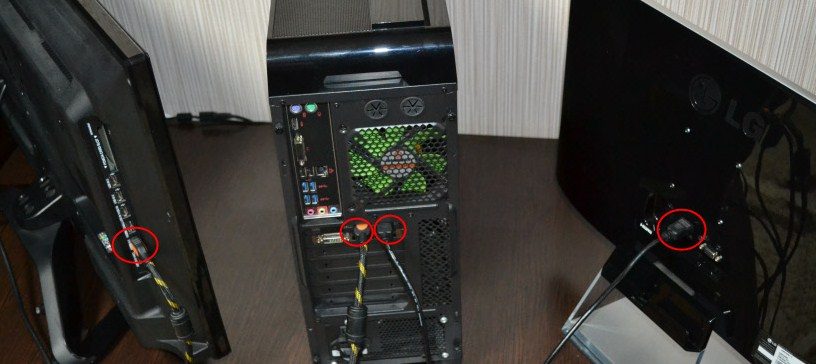
Есть ли какие-то рекомендованные понижающие блоки питания, например, из ассортимента “Чип и Дип”?
Очень интересная, весьма полезная, уникальная статья для пользователей цифрового телевидения.Здесь описана подробно такая вещь как “Телевизионная антенна «Полячка» для дальнего приема DVB-T2”. В этой статье весьма подробно и понятно разобраны вопросы, которые интересуют пользователей цифрового тв. И разобраны все способы пользования. В этой статье много полезного, интересного и уникального. Сам являюсь пользователем домашнего цифрового телевидения. Порекомендую статью своим друзьям и родственникам.
Зачем заморачиваться,и делать вручную,если уже есть готовые усилители сигнал?Большое спасибо за статью,потому что она очень помогла мне с домашним цифровым телевидением! 😀 💡
Мы купили такую антенну на дачу. У нас на дачном участке и до перехода на цифру ловило всего два канала. Многие покупали спутниковую антенну. Мы купили “Полячку” с усилителем “SWA 555 Lux”. Теперь свободно и без помех смотрим 12 каналов. на даче нам хватает. Живем там и зимой, приезжаем туда на выходные, так что без телевизора в зимние вечера там скучно. Самое главное в этой антенне в том. что она легко устанавливается и легко обслуживается. Так что антенной мы довольны, производитель хорошую вещь изготавливает.
В статье рекомендуется спросить у соседей какую модель транслятора они используют, но что делать если у соседей тоже не всегда сигнал чистый? К тому-же, насколько я знаю уже пол-подъезда приобрело такой же, как у первого обладателя цифрового тв :smile:. Благодарю за информацию о возможности регулировки усиления сигнала путем подкрутки винтов на передней панели усилителя, – не знал, обязательно попробую.
У этих антенн в аналоговом режиме бывали проблемы, когда мощный близлежащий передатчик забивал своим сигналом не только свою, но и ряд других частот (т н “отраженный” сигнал). Выловить дальний и слабый передатчик становилось непростой задачей.
Как с этим в цифровом режиме?